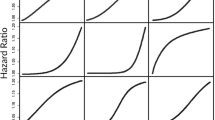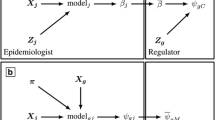Abstract
Much research in environmental epidemiology relies on aggregate-level information on exposure to potentially toxic substances and on relevant covariates. We compare the use of additive (linear) and multiplicative (log-linear) regression models for the analysis of such data. We illustrate how both additive and multiplicative models can be fit to aggregate-level data sets in which disease incidence is the dependent variable, and contrast these results with similar models fitted to individual-level data. We find (1) that for aggregate-level data, multiplicative models are more likely than additive models to introduce bias into the estimation of rates, an effect not found with individual-level data; and (2) that under many circumstances multiplicative models reduce the precision of the estimates, an effect also not found in individual-level models. For both additive and multiplicative models of aggregate-level data, we find that, in the presence of covariates, narrow confidence interval are obtained only when two or more antecedent factors are strongly related to the measured covariate and/or the exposure of primary substantive interest. We conclude that the equivalency of fitting additive versus multiplicative models in studies with individual-level binary data does not carry over to studies that analyze aggregate-level information. For aggregate data, we strongly recommend use of additive models.






Similar content being viewed by others
References
Bjork J, Stromberg U (2002) Effects of systematic exposure assessment errors in partially ecologic case-control studies. Int J Epidemiol 31:154–160
Bjork J, Stromberg U (2005) Model specification and unmeasured confounders in partially ecologic analyses based on group proportions of exposed. Scand J Work Environ Health 31:184–190
Dockery DW, Pope CA, Xu X, Spengler JD, Ware JH, Fay ME, Ferris BG Jr, Speizer FE (1993) An associaton between air pollution and mortality in six U.S. cities. New Eng J Med 329:1753–1759
Gail M, Simon R (1985) Testing for qualitative interactions between treatment effects and patient subsets. Biometrics 41:361–372
Greenland S (2001) Ecologic versus individual-level sources of bias in ecologic estimates of contextual health effects. Int J Epidemiol 30:1343–1350
Greenland S (2002) A review of multilevel theory for ecologic analyses. Stat Med 21:389–395
Greenland S, Poole C (1988) Invariants and noninvariants in the concept of interdependent effects. Scand J Work Environ Health 14:125–129
Greenland S, Robins J (1994) Invited commentary: ecologic studies—biases, misconceptions, and counterexamples. Am J Epidemiol 139:747–760
Koepsell TD, Weiss NS (2003) Epidemiologic methods: studying the occurrence of illness. Oxford University Press, New York, pp 281–307
Kunzli N, Tager IB (1997) The semi-individual study in air pollution epidemiology: a valid design as compared to ecologic studies. Environ Health Perspect 105:1078–1983
Monson RR (1990) Occupational Epidemiology. CRC, Boca Raton
Morgenstern H (1998) Ecologic studies. In: Rothman KJ, Morgenstern H (eds) Modern epidemiology, 2nd edn. Lippincott-Raven, Philadelphia, pp 459–480
Parkin DM, Khlat M (1996) Studies of cancer in migrants: rationale and methodology. Eur J Cancer 32A:776–771
Peto R (1982) Statistical aspects of clinical trials. In: Harnan KE (ed) Treatment of cancer. Chapman and Hall, London, pp 867–871
Pope CA III, Thun MJ, Namboodiri MM, Dockery DW, Evans JS, Speizer FE, Heath CW (1995) Particulate air pollution as a predictor of mortality in a prospective study of U.S. adults. Am J Resp Crit Care Med 151:669–674
Rothman KJ, Greenland S, Walker AM (1980) Concepts of interaction. Am J Epidemiol 112:467–470
Samet JM, Dominici F, Curriero FC, Coursac I, Zeger SL (2000) Fine particulate air pollution and mortality in 20 U.S. cities, 1987–1994. New Eng J Med 343:1742–1749
SAS Institute, Inc. (2004) SAS/STAT® 9.1 user’s guide. SAS Institute, Inc., Cary, NC
Thompson WD (1991) Effect modification and limits of biological inference from epidemiologic data. J Clin Epidemiol 44:221–232
Webster T (2002) Commentary: does the spectre of ecologic bias haunt epidemiology? Int J Epidemiol 31:161–162
Weed DL, Selmon M, Sinks T (1988) Links between categories of interaction. Am J Epidemiol 127:17–27
Author information
Authors and Affiliations
Additional information
Supported by Grant #1 U19 EH000102 from the National Center for Environmental Health, Centers for Disease Control and Prevention, Atlanta, GA.
Rights and permissions
About this article
Cite this article
Thompson, W.D., Wartenberg, D. Additive versus multiplicative models in ecologic regression. Stoch Environ Res Risk Assess 21, 635–646 (2007). https://doi.org/10.1007/s00477-007-0141-2
Published:
Issue Date:
DOI: https://doi.org/10.1007/s00477-007-0141-2




